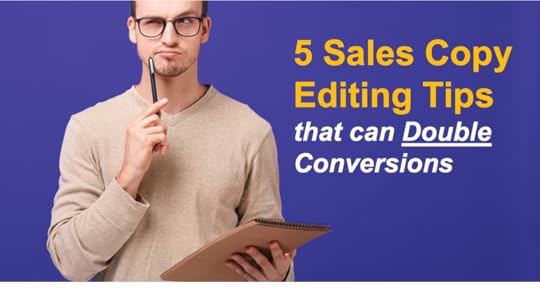Steve Slaunwhite's Blog
May 12, 2021
How to Push the TURBO DRIVE on Your Marketing Copy
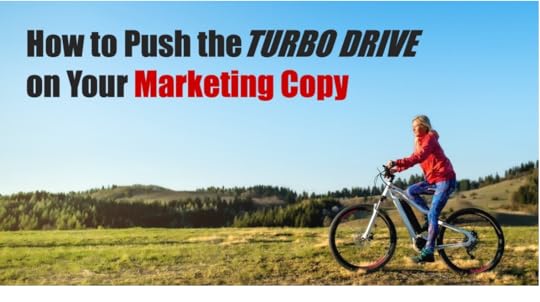
My wife and I stopped by a bike shop last week. We weren’t actively shopping; just curious about the electric-assist bikes (e-bikes) and thought we’d check them out.
The salesperson showed us one and went over the dozens of features. Frankly, it was information-overload.
Then he offered us a test drive.
Soon we were in an empty parking lot across the street, and my wife was sitting enthusiastically on the e-bike. After a quick orientation, the salesperson said, “Okay, when you’re comfortable with the feel and operation, see that lever there?” He pointed. “That’s the turbo drive. Give it a push. Then hang on!”
I watched my wife do a couple of turns around the lot and then, with some trepidation, push the turbo. Zoooooom! She got an instant boost of acceleration. I could see her grinning ear-to-ear. She loved it.
And that’s when I knew we had just bought the e-bike!
I doubt the salesperson realized it, but what he did was use a persuasive copywriting technique. He highlighted the one feature that he knew would sway us. Sure, the other features — battery life, range, warranty, customer reviews, etc. — were important. But it was the fun of pushing the turbo that clinched the sale.
When I teach copywriting workshops, I often call this technique “Highlighting the clincher.” But I now think “Pushing the turbo drive” describes it better!
Here’s how this copywriting technique works:
Review the main features of your product or service.Pick the feature that is most likely to get the prospect excited about the corresponding outcome or benefit.Bring that feature to life in your copy by highlighting and expanding on it.Say, for example, you’re writing an email promoting a free webinar. The topic is “How to Run Effective Online Meetings in the Age of Screen Fatigue.” (I realize the popular expression is ZOOM fatigue but, hey, it’s not their fault!)
When you review the webinar’s main features, you determine that a feature that is likely to get prospects excited is the free 7-Point Online Meeting Checklist, which participants receive as a PDF.
So what you want to do is make that feature front and center in your promotion. Highlight it. Expand on it. Provide an example. Give it a starring role in your “Before and After” story.
Or… you can save it until the end and use it as a motivating extra in your call-to-action.
Either way, your email is going to be more persuasive and likely to get more clicks.
That’s the turbo technique. Try it the next time you’re writing an ad, email or landing page.
This article was originally published on LinkedIn Pulse here.
7 Ways to Write Preview Text that Boost Open Rates
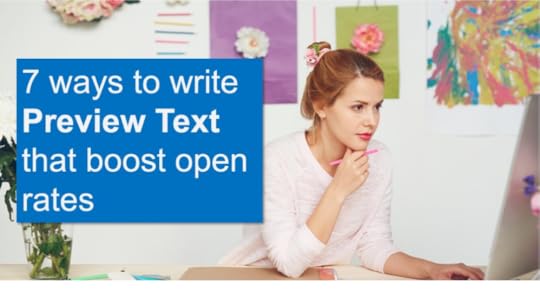
There’s no doubt about it. Subject lines do much of the heavy lifting in getting your promotional emails opened. Recently, I was involved in a split test where one subject line beat the other by just over 200%.
However, the subject line doesn’t go it entirely alone. It gets help on two fronts. One is the From line (a line marketers should pay more attention to, IMHO.) The other is the preview text.
As you may know, preview text (AKA the preheader) is a short line of copy that gives you a “preview” of the email message. It’s often displayed just after the subject line or just below it. Not all email clients show the preview text, but many do.
Preview text is becoming increasingly important in promotional emails because if the reader doesn’t like the preview, they may not open the email.
It’s like noticing a BIG SALE! sign at a storefront, peering through the window, and not liking what you see. So you don’t bother to go in.
Preview text is tricky to write. Unlike subject lines, there isn’t a mountain of split test data to confirm what works. More like a hill. However, based on that hill and my own experience working with clients, here are a few approaches worth trying.
1. Contrast with the subject lineDoes your subject line rely on creating intrigue? Example: Has your marketing copy been to BALI? Then in your preview text, take a more straightforward approach. Example: Four ways to write more compelling benefits using the B.A.L.I. technique.
If your subject line states the benefit or offer more directly, try a little intrigue in the preview text.
2. Take another swing at itIn your subject line, you have one chance—and precious few words—to say something that motivates the reader to open the email. Example: White Paper: How COB technology lowers insurance costs in distribution facilities.
The preview text gives you a second opportunity to make an impact. So explore how you can state the same message but in a new and interesting way. Example: Discover the insurance savings potential for your operations.
3. Establish rapportIt’s tough to break the ice and make a personal connection in a subject line. You just don’t have the room. But you do in the preview text. That is where you can be more conversational. If appropriate, you can even personalize the preview text with the reader’s name. Example: Steve, I’m excited to share these tips with you.
4. Highlight the outcomeMany subject lines focus on drawing the reader’s attention to a problem, need or goal. Example: Do you make these mistakes when writing preview text? That’s essentially the Before in a before and after story. So in your preview text say something about the After—the outcome. Example: Write stronger preview text with these 7 tips.
5. Offer a bonus or incentiveAre you offering a bonus, discount or another incentive that isn’t mentioned in the subject line? The preview text can be the ideal place to promote that. Example: Take 10% off when you register today.
6. Create a sense of urgencyCreating a sense of urgency is a time-honoured principle in persuasive copywriting. That’s why Last chance… in a subject line often works well. But when you haven’t played the urgency card there, consider doing so in the preview text. Example: Registration ends at midnight.
7. The Cracker Jack Box techniqueThe whole point of preview text is to give you a peek inside the email before opening it. So, if there’s something of value in the email itself—a discount coupon, lists of tips, a breakthrough insight—highlight that in the preview text. Example: Tip #4 can double replies to your prospecting emails today.
A final tip: Read your preview text out loud. Although the numbers are still small, people are increasingly listening to their emails with the voice assistant feature on their phones or via Alexa, Nest, or Google Assistant. You want to make sure your preview text sounds as compelling as it reads.
This article was originally published as a LinkedIn Pulse article here.
May 11, 2021
The Fastest Way to Get Better at Just About Anything
 Years ago, while at a conference, I attended a breakout session on personal selling skills. The speaker, a well-known sales trainer, was terrific. He walked us through several helpful tips and strategies. I took copious notes.
Years ago, while at a conference, I attended a breakout session on personal selling skills. The speaker, a well-known sales trainer, was terrific. He walked us through several helpful tips and strategies. I took copious notes.
During the Q&A section, someone asked him, “What’s the fastest way to become good, really good, at personal selling?” I expected the speaker to jump at the opportunity to say, “Take one of my courses” or “Read my book”. At the very least, I assumed he’d recommend practising the selling tips he had just taught us.
But he didn’t say any of that.
Instead, he advised us to simply, “Spend one hour a day getting better.”
Another audience member pressed him further. “Okay, but spend that hour doing what, exactly?”
“It doesn’t matter,” the speaker said to everyone’s astonishment. “It’s not the how that’s important. You’ll figure that out. The important thing is to commit to spending a block of time each week to getting better — somehow. I recommend an hour a day, but any schedule will work, so long as it’s weekly. If you do just that, trust me, you’ll get better. Much better. Fast.”
That advice intrigued me. This was early in my copywriting career (late 1990s) and email marketing was just emerging. I wanted to get better at that. So, I decided to give the speaker’s advice a try. When I got back to my home office, I pulled out my calendar and scheduled one hour a day to mastering email copywriting.
I didn’t have any particular plan. As the speaker recommended, I focused on just showing up, and didn’t worry too much about what I should actually do during those hours. Mostly, I improvised. Some days I’d read articles. Other days, I’d study email marketing examples.
Not surprisingly, I began to get better. In fact, in just a few weeks, my skill-level in email copywriting bore little resemblance to where it was when I began. In fact, I was becoming really good!
When you think about it, it’s not much of a surprise that this technique worked so well. When you invest serious time into anything, you often make progress, even if you’re merely stumbling along.
If you go to the gym five days a week, you’re going to get in better shape. Even if you’re not following the “perfect” workout routine.
If you practise guitar regularly this month, you’re going to play better next month. Even if you’re just following tutorials on YouTube.
That’s not to say methodology isn’t important. Of course, it is. But the advantage of following a schedule — say, an hour a day — is that you’re moving forward and gaining momentum. You’re also learning what works and what doesn’t for you. You may read a few articles and find that you’re more suited to video lessons. You may watch some videos and discover that you get more traction with live instruction and coaching.
The very act of spending focused time on getting better will lead to you find the best ways to get better.
So, if you want to become really, really good at something, don’t go searching for the perfect book, course or mentor. At least, not yet. Start by scheduling your “getting better” time. Put those blocks of time in your calendar.
Then, show up.
“Getting better” will naturally flow from there.
This article was originally published in LinkedIn Pulse here.
The post The Fastest Way to Get Better at Just About Anything appeared first on Steve Slaunwhite.
How to Write Webinar Titles that Grab Attention
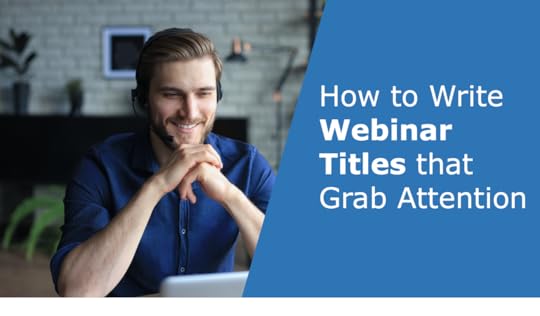 A friend of mine contacted me last week. She was in a near-frantic state. Her new webinar was about to be promoted — that morning! — and she had yet to decide on a title.
A friend of mine contacted me last week. She was in a near-frantic state. Her new webinar was about to be promoted — that morning! — and she had yet to decide on a title.
She had a good reason to feel anxious. After all, the title of your webinar plays a huge role in its success. Especially if you’re relying on it to generate leads.
For example, if you were a sales professional, which webinar would get your attention?
Social Selling: An Alternative to the Diminishing Effectiveness of Executive-Level Cold Calling.Cold Calling is Dead: Learn the New “Silver Bullet” for Landing Appointments with VPs and CEOs.You’d likely click and learn about the second one.
In fact, I suspect the second webinar would get two to three times more registrations than the first. Even though both webinars are otherwise the same.
Webinar titles are that important.
So, how do you come up with one that will instantly get the attention and interest of prospects? Here’s a brainstorming technique worth trying…
STEP 1: Determine the big promise.Why would a prospect drop what they’re doing and sign up for your webinar? What’s in it for them? What are they going to be able to do, solve, or achieve? (Notice I didn’t say learn. Learning is work. Getting, solving, strengthening, mastering, overcoming, knowing, achieving — are all benefits.)
I call this the “big promise” of your webinar, and you need to figure that out.
One way to do that is to finish this sentence: By attending our webinar, prospects will [know…, be able to do…, get a 3-step solution for…, understand how to accomplish…]
By the way, the best big promises are practical and immediate. Practical in that the information can be readily put into action. And immediate in that the prospect can benefit from the webinar soon afterwards. (The farther away a benefit seems to a prospect, the fuzzier and more uncertain it becomes.)
In fact, when I write webinar promotions for clients, I’ll often highlight those practical-tactical takeaways prospects can use right away, ideally that same day.
Step 2: Explore ways to communicate the big promise with impact.Once you have your big promise nailed down, explore title ideas that clearly communicate it.
Clarity is king. That’s why many webinar titles are not particularly creative, yet still effective. For example, I once noticed a webinar called: Increasing Conversion Rates on White Paper Landing Pages. Not that clever, but it got my attention!
You can be creative with your webinar titles. If you do, I recommend a two-tiered title structure. Have a short main title that’s imaginative and curiosity-raising. Then, add a sub-title that clarifies the promise.
For example, if this article was a webinar, I might have called it:
Main title: The “Wow!” TechniqueSub-title: How to Write Webinar Titles that Grab AttentionThat’s a nice setup for the final step in the brainstorming process…
STEP 3: Use the “Wow!” technique to pick a winner.Once you have a few title ideas, here’s a can’t-lose way to pick the best one.
Imagine you’re the prospect. Then, look at your list of title ideas and gauge which one is most likely to elicit the reaction, “Wow. That’s interesting! I’m going to drop what I’m doing and check this out right now.”
If there’s one title idea that gets that reaction, you have your winner. Go with it! But if you have two or three candidates, pick the one that scores highest on the “Whoa!” scale. (Yes, score them.)
I actually used these three steps while brainstorming with my frantic friend last week. In just a few minutes, we came up with a solid webinar title. Did it work? She reports that, so far, webinar registrations are above expectations.
I suspect the title helped!
This article was originally published in LinkedIn Pulse here.
The post How to Write Webinar Titles that Grab Attention appeared first on Steve Slaunwhite.
Do You Know the Copywriter’s Song?
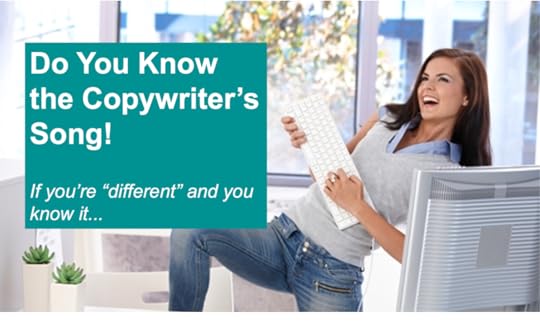 Most of us have fond memories of the children’s classic, “If you’re happy and you know it, clap your hands.” (There’s a fun karaoke version here.)
Most of us have fond memories of the children’s classic, “If you’re happy and you know it, clap your hands.” (There’s a fun karaoke version here.)
If I were to rewrite that tune for copywriters, I’d change “happy” to “different”.
Why?
Because emphasizing differences is key to effective copywriting, especially if you need your copy to boost conversions, leads and sales.
Here’s a case in point, based on a podcast I did a few years ago…
It was my wife’s birthday last week. A milestone. So I decided to order one of those wonderfully corny, slightly embarrassing lawn signs and have it secretly set up in the middle of the night.
But when I Googled “birthday lawn signs” for my area, I was stunned. There were dozens of companies that offered this service. They all looked alike. All had pictures of lawn signs on their websites. All had midnight delivery service.
The sameness from one company to another made it difficult to choose. So I just randomly phoned a few and asked questions.
The guy at the second company I called said something that immediately sold me. He said, almost matter-of-factly, “We don’t just write your wife’s name on the sign with a marker, like most companies do. We use a professional calligrapher who hand paints it on artistically.”
Wow.
You can guess why that persuaded me! Which would I rather my wife see on the front lawn in the morning? Her name scribbled in magic marker? Or hand painted in professional calligraphy?
It was a no brainer.
But if I hadn’t called that company, I wouldn’t have known that. Because they did NOT have that information on their website!
Instead their website looked the same, and said basically the same things, as every other lawn sign company.
As a result, I suspect they are losing sales because you don’t attract customers by blending in. You attract them by standing out.
And the best way to stand out is to take something that differentiates you – a feature, an advantage, even a quirky characteristic – and highlight that in your marketing copy. Make it jump off the screen or page.
Think about your own business for a moment.
Say you’re a freelancer who writes website content, blog posts and marketing emails for coaches. There are a lot of other copywriters who can say the same thing. What makes you so different?
It might be that you were once a professional coach yourself. Would your prospects see that as an advantage? Of course they would.
Say you own a leadership training firm. There are more leadership trainers around than coffee beans at Starbucks. How do you stand out? Well, perhaps you’re one of the few who specializes in working with retail managers and supervisors. Your niche is what differentiates you.
Say you’re the marketing director of an AI tech firm. What could get your company noticed in that increasingly competitive market? Perhaps it’s your company’s project track record. Unlike so many new players, your company has implemented dozens of platforms with documented results. It didn’t just jump in because AI is the next big thing. Your company is way ahead of that group of wannabes.
Whatever it is that makes you different, emphasize that on your website and in your other marketing materials.
It doesn’t have to be a huge difference. Even a minor feature, characteristic or advantage you have that most of your competitors don’t have can be enough to make you stand out and get noticed.
So, when you’re writing marketing copy, don’t forget to sing the tune: If you’re different and you know it… say so, loudly!
This article was originally published in LinkedIn Pulse here.
The post Do You Know the Copywriter’s Song? appeared first on Steve Slaunwhite.
7 Mistakes That Will Freeze Your Cold Prospecting Emails
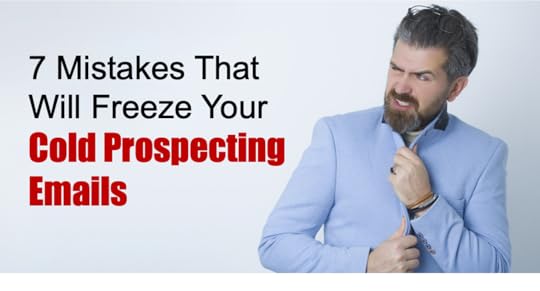 In physics, absolute zero is the temperature when, in the most fundamental sense, nothing happens. Literally, nothing. It’s so cold, atomic particles don’t even move.
In physics, absolute zero is the temperature when, in the most fundamental sense, nothing happens. Literally, nothing. It’s so cold, atomic particles don’t even move.
That’s a good analogy to describe how just one writing mistake can glaciate your already cold prospecting email. Make just one mistake and your prospect likely won’t respond. They may not even read past the first sentence!
I’ve been seeing this a lot lately in my copywriting workshops with sales teams. Just one blunder in a cold prospecting email kills response rates. The good news is, simply avoiding these chill-inducing gaffes can warm your emails significantly. In fact, I’ve seen response rates jump 200-300%, even with a “hard” call-to-action like, “Let’s schedule a meeting.”
So, if you’ve been struggling to write cold prospecting emails that work, check that you’re not making any of the following blunders.
Lack of real personalization. The more the prospect sees your email as a message written just to them, the more likely they are to respond. So, you need to do your homework. You need to figure out how to break the ice with your prospect and point to a Pain Point Problem they’re facing that your solution addresses. Anything less and you’ll get few, if any, replies. (The good news is, you can do this homework in just 15 minutes.)Wrong writing style. Sales emails that seem template-ish, reek of corporate-speak or, worse, read like polished marketing copy, never work. Remember, this is a personal message from you to the prospect. Try this: Imagine you’re chatting with the prospect in person. Then, use that same conversational style in your email.Not focusing on the right “pain point” problem. Ultimately, a prospect will respond to your email because they think (hope) your solution might be the answer to a specific and immediate problem. So, you need to find out what that frustrating “pain point” is and make that the focus of your email. That’s why doing your homework is so important. (See #1.)Pitching instead of positioning. It can be tough to resist enthusiastically describing your product or service. But in a cold prospecting email, your aim is to position, not pitch. If you jump into presentation mode, you’ll lose the prospect. Instead, position your product/service as an idea worth considering. For example, “Customers are telling us that [insert product] is helping them to [insert results]. Are you interested in learning if you can get similar results?”Lack of social proof. If there is one ingredient every cold prospecting email needs it’s social proof. I’ve seen big boosts in response rates for my clients just by name-dropping a few customers, mentioning a customer success story, pointing to a number of clients (“We’ve worked with 27 companies in your industry…”), and so forth. Always add social proof.Being long-winded. Have you ever had a stranger come up to you and jabber non-stop? Chances are, you looked for the first opportunity to get away! In a cold prospecting email, the prospect usually doesn’t know you. You’re a stranger. So, you must keep your email short and to-the-point. Remember, a cold email isn’t a sales conversation, it’s an invitation to start one.Asking for too much, too soon. You need to be careful with your call-to-action. If you ask for too big a step, the prospect is unlikely to respond. However, you do need a call-to-action that measurably moves the sales conversation forward. Try this: Put yourself in the prospect’s shoes and ask, “What next step makes the most sense to me in order to learn more about this solution?” Then, use that next step in your email.There are plenty of other mistakes I’m seeing in prospecting emails, but these are the most common. Avoid them and then watch what happens. In my experience, your response rates will go up.
This article was originally published in LinkedIn Pulse here.
The post 7 Mistakes That Will Freeze Your Cold Prospecting Emails appeared first on Steve Slaunwhite.
Coming Up With Blog Topics that will Grow Sales
 I was speaking with a marketing consultant recently who rattled off ideas for generating more leads and sales from a company blog. She touted linking strategies, SEO tactics, social media apps, coding tricks, to name a few.
I was speaking with a marketing consultant recently who rattled off ideas for generating more leads and sales from a company blog. She touted linking strategies, SEO tactics, social media apps, coding tricks, to name a few.
All great ideas.
But there’s one thing she didn’t mention that surprised me…
Topics!
Surely, the topic of a blog post — or any type of content, for that matter — plays a pivotal role in whether or not it helps bring in more business.
After all, if the topic isn’t interesting to customers, few will read the post. Or, if the blog post does get attention, but doesn’t ultimately pique interest in your products or services, it’s still a dud. (And all the SEO/coding/linking strategies in the world won’t save it.)
So, coming up with blog topics that attract readers and drive leads and sales is crucial.
The good news is, there’s a simple way to brainstorm and strategize blog topics.
But before I walk you through that technique, keep in mind that a good topic for a post must meet two criteria.
It must be of high-interest to your customers.It must position your company as a go-to provider of what you do or sell.If your blog post doesn’t check those boxes then it’s just words on the screen. You might get some SEO value out of the post, but that’s it.
Of course, you want your blog to do more than just please the Google bots. You want it to help get leads and sales.
So, here’s the technique…
First, think about your customers. If you have a Buyer Persona handy, pop that up on your screen.
Next, think about what that customer’s world is like right now. What challenges are they facing? What goals are they eager to achieve? What pressures are they under? What’s on their front burner today?
Then, brainstorm a list of topics likely to be helpful to them. Think about tips you can share, stories that might inspire them, insights they can take advantage of, information they need, lessons you can teach them, ideas they can run with, how-tos you can walk them through, and so forth.
Make a long list. Don’t stop until you have a few decent ideas.
Once you have those, go through your list and cross off any topic not related to what your company does or sell. There’s no sense publishing a blog post on how to make the ultimate blueberry muffin if your company does big data consulting!
Finally, go through your list and circle those remaining topics that are of high-interest to your audience. Notice I didn’t say merely say “interest”. High interest. Zero-in on those topics likely to gain the instant attention of your customers and get them clicking and reading.
This brainstorming technique only takes a few minutes. Yet, chances are, you’ll come up with at least a couple of topic ideas that are golden.
And keep in mind you can use this technique for other types of content, such as newsletter articles, white papers, ebooks, and even webinars.
Give it a try. If a better blog topic can get just 50% more customers reading the post and becoming more interested in your offerings… well… you decide what that’s worth to you!
This article was originally published in LinkedIn Pulse here.
The post Coming Up With Blog Topics that will Grow Sales appeared first on Steve Slaunwhite.
5 Sales Copy Editing Tips that can Double Conversions
When I write sales copy I give it all I’ve got, as many copywriters do. I lean in and apply all I know about conversational writing, persuasion psychology, and good old-fashioned selling. So, when I finish a draft, I sometimes give myself a congratulatory pat on the back and think, “This copy is pretty darn good!”
How’s that for vanity?
However, when I go back to edit the draft, something important happens.
I almost always find ways to make it better.
In fact, during the editing process, I’ll often see areas where I can make the copy stronger —and, therefore, more likely to increase conversions, leads or sales.
With that in mind, here are five editing tips that, in my experience, make the biggest impact on the effectiveness of your marketing copy.
Tip #1: Check the front burnerProspects will read (or scan) your sales copy because they believe it might offer a solution to a problem or desire.
But here’s the challenge: Your prospects have many problems and desires. You can’t know for sure which of those are on their front burners at the moment.
So, when editing your copy, check that you’re highlighting the problem or desire in a way that agitates or excites the prospect — and whets their appetite for your offer.
Put the problem or desire on the prospect’s front burner!
Tip #2: Let “Mr. So What” be your co-editorMr. So What is definitely a nag. As you review your sales copy, he’ll constantly be chiming in with, “So what?” “Who cares?” “What’s in it for me?”
But as annoying as this imaginary co-editor is, he’ll help make your copy more persuasive. That’s because he’ll point to opportunities where you can present more meaningful benefits — the kind of benefits likely to sway prospects.
So, don’t shoo away Mr. So What. Invite him to scrutinize your copy to ensure you’ve fleshed out the most enticing benefits and are communicating those with power and impact.
Tip #3: Add oomph to your call-to-actionIf prospects don’t click, call or otherwise respond, your sales copy has failed, no matter how well-written you thought it was. So, check that your CTA has enough oomph to motivate prospects to take that step.
A simple Learn More or Order Now might suffice. But more likely than not, you’ll need to do a bit more persuading and reassuring, by:
Adding a “reminder” benefit.Highlighting the guarantee.Emphasizing the consequences of not responding. (Example: Why struggle even one more day with this [insert problem]…)Making the price seem cheap compared to the value. (Example: For the cost of a Starbuck’s latte each day, you can be enjoying… )Incorporating a testimonial or other form of social proof.When editing, check that your CTA is going to do the job. If it isn’t, add more oomph.
Tip #4: Take the 5% challengeNothing will kill your sales copy faster than wordiness. Even one long-winded passage can cause prospects to bail and, therefore, not respond to your offer. So, you need to make your copy tight, tight, tight!
A simple way to do that is to take the 5% challenge.
As you edit your copy, challenge yourself to cut 5% of the word count, without sacrificing key messages or the conversational flow. This may require you to think of a shorter way to say something, which often ends up being a better way to say it.
Whenever I do this 5% thing, the copy almost always ends up being more crisp and persuasive.
Tip #5: Imagine you’re the prospect and ask, “Would this sell me?”This is probably the most effective editing technique of all. Imagine you’re the prospect and read the copy as they would. As you do…
Notice if the headline grabs you.Notice if the opener pulls you into the message.Notice if the features and benefits persuade you.Notice how motivated you feel when you get to the CTA.Ask yourself, as the prospect, “Does this message build my interest in the offer and motivate me to take the next step? If not, what would need to change about this copy in order for me to feel that way?”
Just like Mr. So What, your imaginary prospect is also a great co-editor!
A famous writer once said, “You can write your way to good, but you can only rewriteyour way to great.” Editing is rewriting. So, try these tips the next time you write sales copy you think is good. Take another pass to make it great!
This article was originally published in LinkedIn Pulse here.
The post 5 Sales Copy Editing Tips that can Double Conversions appeared first on Steve Slaunwhite.
Will Choosing the Wrong Pain Point Problem Sink Your Sales Copy?
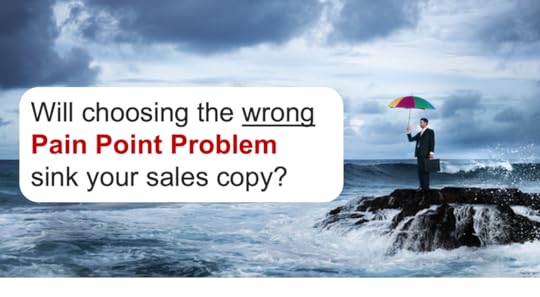 I teach a lot of virtual classes and training sessions, which requires me to be on camera. Obviously, I want to look good. At least, to the extent my frustratingly non-photogenic mug will allow.
I teach a lot of virtual classes and training sessions, which requires me to be on camera. Obviously, I want to look good. At least, to the extent my frustratingly non-photogenic mug will allow.
The trouble is, I’ve never been able to come up with a set-up that makes me look even marginally okay. Over the years, I’ve bought expensive webcams, purchased special lighting, experimented with backgrounds, you name it.
I’ve even followed someone’s advice to wear a bright white shirt. It glowed so much on camera I looked like a Vegas act!
This was becoming a big problem for me. I need to look professional to students and clients. Yet, every time I saw my blurry/low res/too dark/washed out/just plain poor image on video, my confidence took a hit.
It was a pain.
And that’s the point.
Because if some smart marketer had a product that was the solution to that misery, and highlighted that in her sales copy, it would get my attention. I would read that copy with interest (and hope.) I’d be motivated to buy.
And, as it turns out, that’s exactly what happened.
Recently, I came across a promotion for an app that turns my iPhone into a webcam. It works like a charm, and I now consistently look okay on camera. (“Okay” is a big improvement for me!)
What that smart marketer did was choose the right “Pain Point Problem” to highlight in her sales copy. She wisely considered the big challenge or goal her prospects are dealing with — what the real pain-in-the-butt is for them — and then positioned the app as the cure.
That’s crucial when writing sales copy. Because if you choose a Pain Point Problem that doesn’t resonate with prospects, your copy will flop.
Imagine if that app marketer had chosen to focus instead on “convenience”. She would have written something like: No more webcams to install and configure. Just plug in your iPhone, turn on the app and — ta da — you’re cam-ing!
At best, all that sales copy would have done is position the app as a nice-to-have.
What you want is for your solution-based product or service to be seen as a must-have.
And to make that impact, you need to focus on the right Pain Point Problem.
How do you do that?
For starters, think about what your prospects are dealing with at this moment. What are their most pressing problems and goals? What is keeping them up at night? What frustrates them? What are they under pressure to accomplish? What hurts?
Then, select the biggest pain your product or offer credibly alleviates.
Ideally, your Pain Point Problem should have the following characteristics:
It’s an immediate problem or goal.It’s a big concern for prospects.It’s a pain for them!If a Pain Point Problem meets that criteria — and your product or service is a solution — your prospects are going to be hard-pressed to ignore your promotion. In fact, your sales copy stands an excellent chance of gaining their attention and getting them eager to learn more.
So, to quote the ancient Knight from the third Indiana Jones movie, when deciding on a pain point to highlight in your sales copy, “Choose wisely.”
This article was originally published in LinkedIn Pulse here.
The post Will Choosing the Wrong Pain Point Problem Sink Your Sales Copy? appeared first on Steve Slaunwhite.
3 Copywriting Formulas You Don’t Know (But Should!)
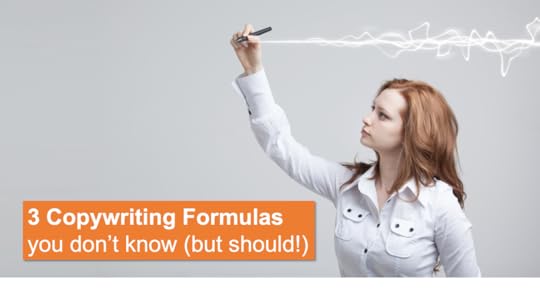 I admit I have a love-hate relationship with copywriting formulas.
I admit I have a love-hate relationship with copywriting formulas.
On the one hand, they capture the best practices of writing sales copy in a way that’s easy to remember and apply. On the other, I don’t like the “paint by numbers” aspect because that can limit thinking and creativity.
After all, you want to be free to paint outside the lines occasionally!
That said, formulas can be helpful as a tool (not a rule) for writing compelling sales copy. So, it’s smart to have a few good ones in your writing toolkit.
There are many well-known copywriting formulas: AIDA, The Motivating Sequence, and The 5 Ps, to name a few.
Here are three more you probably haven’t come across. That’s because I developed these for my copywriting workshops and rarely share them publicly — until now.
1. The RICE formula for B2B marketing emailsThis one is handy for writing promotional emails targeting B2B prospects, such as business owners, managers and other professionals.
RelevantImmediateConciseEasy-to-scanB2B prospects are often busy; in work-mode. They see the week ahead filled with tasks, projects, goals and expectations. So they’re most likely to respond to emails that are relevant to what’s on their plate right now and give them an immediate benefit.
And because these prospects receive dozens of emails each day, they don’t have time to wade through a lot of information. So, your emails need to be concise and easy-to-scan.
By the way, concise doesn’t necessarily mean short. It simply means you’re making every word count and keeping your copy as tight as possible.
2. The BALI formula for writing about benefits.When reviewing sales copy written by clients and students, I’ve noticed that many fall into the trap of writing benefit lines in just one or two ways. To the reader, that can get dull quickly. The BALI formula reminds you of all four variations so you can mix things up.
BeforeAfterListImagineBefore refers to stating the benefit and then the feature. For example:
[Benefit] Want to vanquish night-before presentation jitters? [Feature] In the workshop, you’ll master a 3-step technique for…
After refers to stating the benefit after the feature. For example:
[Feature] Learn a 3-step technique for delivering presentations with confidence. [Benefit] No more night-before jitters!
List refers to stating the main feature and then a bullet list of benefits. This variation works well when there are multiple benefits for a single feature. For example:
[Feature] You’ll walk away with a 3-step strategy that will enable you to:
[Benefit][Benefit][Benefit]Imagine refers to bringing the benefit vividly to life using an example, scenario or story. For example:
Imagine giving an important presentation that is pivotal to your career or business. It’s a tough group. They’re staring skeptically at you as you begin. You could be nervous and uncertain – Who wouldn’t be? – but you’re not. Why? Because you learned a 3-step strategy…
I wish I could say I came up with this formula while sitting on a beach in BALI! Sadly, I was in my home office during the pandemic lockdown.
3. The 4 Cs formula for writing a headlineThis is a well-tested formula for brainstorming headlines and evaluating candidates. I find it works well for B2B ads, emails, landing pages and other offer-driven promotions.
Communicates a benefitCreates a sense of urgencyCredibleCreativeTo use this formula for brainstorming, start with the first C. Jot down headline ideas that communicate the big benefit.
Next, explore ways to give it a “now” factor by creating urgency or another compelling reason to pay attention now.
Next, check that it’s credible. Contrary to popular belief, headlines with exaggerated claims don’t work well — particularly with B2B offers.
Finally, play with ideas for making your headline interesting, fresh, inventive or otherwise creative. What can you say that will make it pop?
Does a winning headline need to have all those characteristics? No. There are always outliers. However, in my experience, the closer your headline is to checking off those four Cs, the more likely it is to work well.
So, those are the three copywriting formulas you may not know but should. Give one of these a try the next time you’re writing sales copy. Just remember that these formulas are tools, not rules. Don’t ever let a formula replace your thinking and imagination.
This article was originally published in LinkedIn Pulse here.
The post 3 Copywriting Formulas You Don’t Know (But Should!) appeared first on Steve Slaunwhite.

